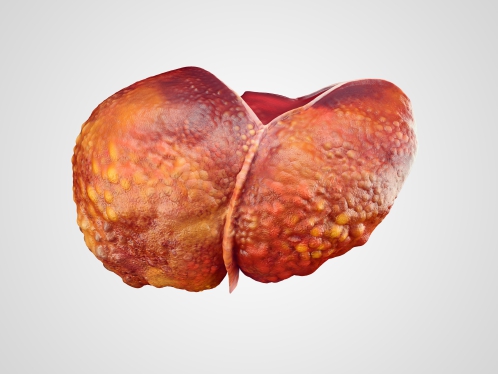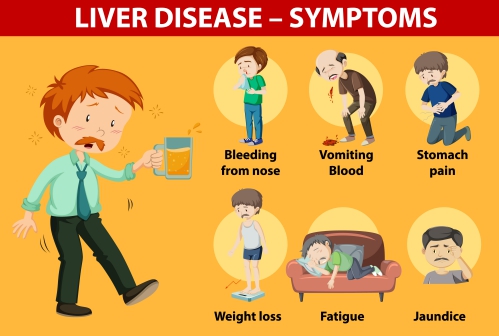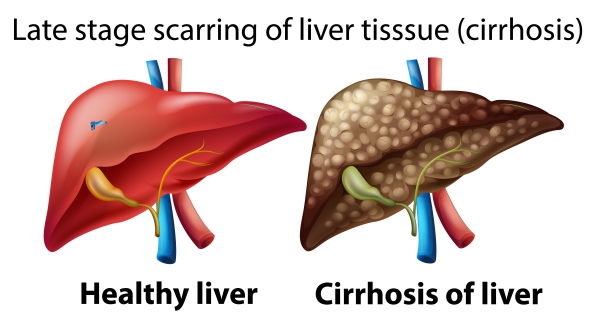What is alcoholic liver disease?
Alcoholic liver disease, also known as alcoholic hepatitis, is an inflammatory condition affecting your liver. It is due to excessive long-term consumption of alcohol. This condition can lead to liver cirrhosis which is scarring of the liver. Liver cirrhosis is a life-threatening condition. The liver is an organ located beneath your ribs on the right side of the upper abdomen. It is responsible for the production of bile which helps to digest fats in the small intestine during digestion. The liver also produces proteins and cholesterol. In addition, the liver represents the human body’s primary filtration system as it removes toxins from your bloodstream.
Alcohol abuse is common worldwide and is estimated to affect around 18% of adults in the United States. Alcoholic liver disease affects 4% of adult US citizens. In the year 2010, around 493,000 deaths were attributed to alcoholic liver disease. Alcoholic hepatitis can occur at any age but is more common in people aged between 20-60years. Women are more at risk of the adverse effects of alcohol. Hence, women develop alcoholic liver disease after a shorter period and smaller amounts of alcohol abuse than men.
What causes alcoholic liver disease?
Alcoholic liver disease occurs when you drink too much alcohol for an extended period of time. When the liver breaks down alcohol, highly toxic chemicals are produced which trigger inflammation of your liver cells. With time, these cells will be replaced by scars which impairs your liver function. Liver cirrhosis is the final stage of alcoholic liver disease and is deadly.

What are the risk factors of alcoholic liver disease?
The most important risk factor for alcoholic liver disease is the amount of alcohol you consume and for how long you have been taking it. Usually people who develop this condition have consumed more than 100 grams of alcohol daily for at least 20 years. There are other factors which may increase your risk of developing alcoholic liver disease and these include:
- Sex: Females are more at risk of developing this condition as alcohol has more adverse effects on their liver than males. Therefore, women develop alcoholic liver disease after a shorter period and smaller amounts of alcohol abuse than men.
- Binge drinking: Consuming more than 4 drinks within 2 hours for women and 5 drinks for men may increase your risk of developing alcoholic liver disease.
- Race: Blacks are more at risk of developing alcoholic hepatitis.
- Obesity: Being obese and drinking alcohol excessively may increase your risk of developing alcoholic liver disease.
What are the signs and symptoms of alcoholic liver disease?
The signs and symptoms of alcoholic liver disease include:
- Jaundice: This is yellowing of your skin and the whites of your eyes. This is the more common sign of alcoholic liver disease.
- Loss of appetite: Alcohol suppresses the appetite and most calories are obtained from alcohol which can lead to malnutrition.
- Abdominal tenderness: The area where the liver is located is often painful. This is because the liver is enlarged and inflamed.
- Nausea and vomiting
- Excessive fatigue
- Low grade fever
- Ascites: This is accumulation of fluids in your abdomen.
- Confusion: Confusion may occur as toxins are being accumulated due to an impaired liver function. Lethargy may be present as well.
- Increased respiratory rate
- Darkening of urine
- Peripheral edema: This is swelling of your feet and ankles.
- Altered hair distribution
- Gynecomastia: This is enlargement of the breast tissue in males.

Making a diagnosis
To make a diagnosis your doctor will first take a detailed history from you to know more about your symptoms. After the history taking, your doctor will perform a thorough physical examination to look for signs of alcoholic liver disease. Your doctor may order some tests to confirm the diagnosis and these include:
- Complete blood count (CBC): A CBC is done to assess for the presence of anaemia and a low platelet count which may be present due to inflammation of your liver.
- Screening blood tests: Some tests may be done to rule out other diseases. Tests for hepatitis B and C are done as they can aggravate alcoholic liver disease.
- Liver function test (LFT): An LFT is done to assess the condition of your liver. This involves the measurement of the level of albumin (a protein produced exclusively by the liver), bilirubin and prothrombin time (this gives an indication about how well your blood clots as the substances responsible for blood clotting is made by the liver). The severity of the increase in bilirubin level and inability to form blood clots properly reflects the severity of alcoholic liver disease.
- Ultrasonography: Ultrasonography provides a good evaluation of the liver and provides guidance when performing a liver biopsy. This test is inexpensive, noninvasive and widely available. This test can detect any enlargement of the liver, gallstones or liver tumours.
- Liver biopsy: This test involves your doctor inserting a needle through your upper abdomen to reach your liver in order to take a small sample to be analysed under the microscope. This test is not always required but can be used to confirm the diagnosis and determine the presence or absence of cirrhosis.

What are the treatments of alcoholic liver disease?
The treatment options of alcoholic liver disease include:
- Quit drinking: This can help to prevent progression of the disease and possibly reverse liver damage done.
- Diet: As people who suffer from alcoholic liver disease also suffer from malnutrition, the diet need to be adjusted to provide for the vitamins and nutrients they lack.
- Medications: Corticosteroids can be used on a short-term basis to help decrease the inflammation of your liver. This medication should not be used for long periods of time and failing kidneys.
- Liver transplant: People with severe alcoholic liver disease have a high risk of mortality without liver transplant.

What are the complications of alcoholic liver disease?
If alcoholic liver disease is left untreated, the following complications may ensue:
- Esophageal varices: This is when the veins along your esophagus- the muscular tube connecting your mouth to your stomach- get enlarged and may cause serious internal bleeding.
- Hepatic encephalopathy: As the damaged liver cannot function properly, the toxins that are normally removed, accumulates and affects your brain. This can eventually lead to coma.
- Ascites: This is when fluids accumulates in your abdomen. This fluids may become infected that will require the use of antibiotics. Ascites is not life-threatening but may indicate an advanced stage of the disease.
- Kidney failure: When your liver is damaged, it can decrease the blood flow to your kidneys which may lead to kidney failure.
 Liver cirrhosis: Liver cirrhosis is the final stage of alcoholic liver disease and is deadly. This scarring of the liver can result in liver failure.
Liver cirrhosis: Liver cirrhosis is the final stage of alcoholic liver disease and is deadly. This scarring of the liver can result in liver failure.
Prognosis
The prognosis of alcoholic liver disease depends on whether liver cirrhosis has already occurred and whether the person has stopped drinking. In people hospitalized with alcoholic liver disease, the 30-day mortality rate is about 15%. Unfortunately, in severe alcoholic liver disease, the 30-day mortality rate reaches 50%. Stopping alcohol consumption, is of utmost importance to prevent the progression of the disease and prevent the development of complications.
Source:
J. Alastair, I. and Simon, M., 2016. Davidson's Essentials of Medicine. 2nd ed. London: ELSEVIER.
Parveen, K. and Michael, C., 2017. Kumar & Clarks Clinical Medicine. 9th ed. The Netherlands: ELSEVIER.
Heuman, D., 2020. Alcoholic Hepatitis: Practice Essentials, Background, Etiology And Pathophysiology







